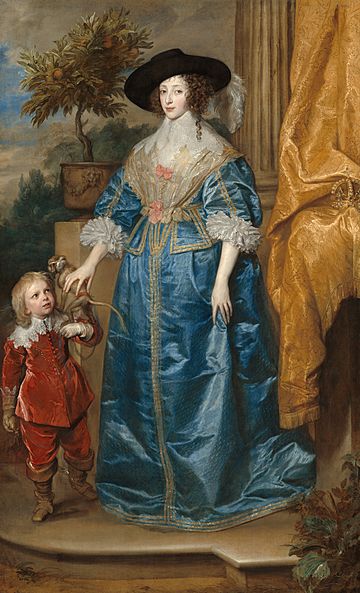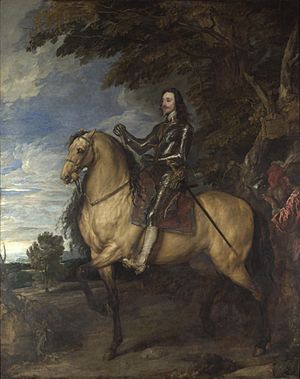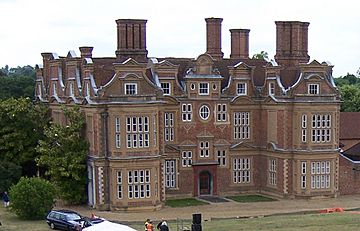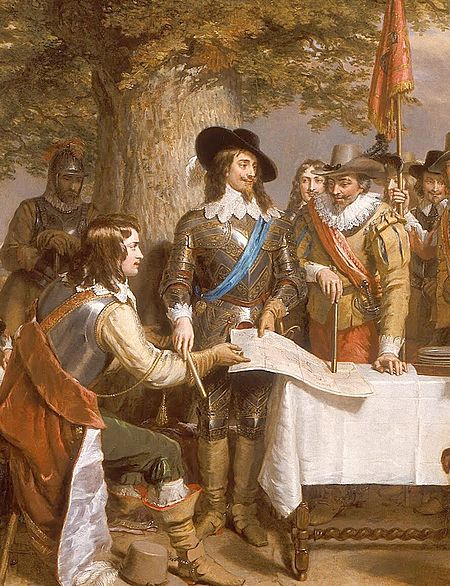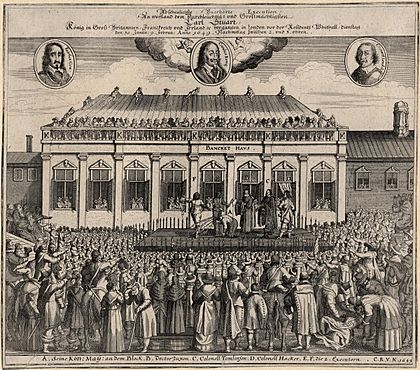Caroline era facts for kids
| 1625 – 1642 (1649) | |
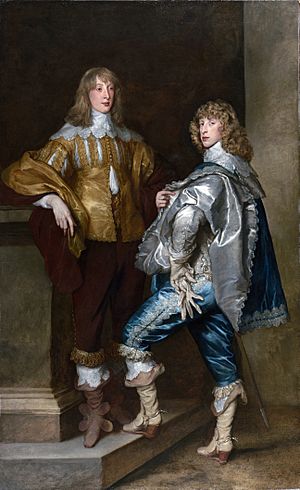
|
|
| Preceded by | Jacobean era |
|---|---|
| Followed by | Interregnum |
| Monarch | Charles I |
The Caroline era was a time in English and Scottish history. It is named after King Charles I, who ruled for 24 years (1625–1649). The name "Caroline" comes from Carolus, which is Latin for Charles.
This period came after the Jacobean era (when Charles's father, James I, ruled). It also included parts of the English Civil War (1642–1651). After the Caroline era, there was a time called the English Interregnum before the monarchy returned in 1660. Don't mix it up with the Carolean era, which was when Charles I's son, King Charles II, ruled!
The Caroline era was a time of growing disagreements. People argued a lot about religion, politics, and how society should work. These arguments were mostly between the King and his supporters (called Royalists) and those who supported Parliament. Even though the Thirty Years' War was happening in Europe, Britain stayed mostly peaceful. But inside the country, the tension between the King and Parliament grew worse.
Despite these problems, arts and sciences still made progress. This period also saw new colonies being started in North America. Places like Carolina, Maryland, Connecticut, and Rhode Island were founded between 1629 and 1636. Older colonies like Virginia, Massachusetts, and Newfoundland also kept growing. In Massachusetts, the Pequot War in 1637 was the first big fight between English settlers and Native Americans.
Contents
Arts and Culture in the Caroline Era
The King loved and supported the arts and architecture. This helped them to reach very high standards. However, theatre was not as strong as it had been in Shakespeare's time. Big arguments about politics and religion affected all the arts.
Poetry: Cavaliers and Metaphysicals
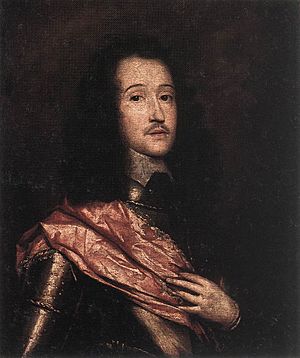
During the Caroline period, two main groups of poets became famous. They were the cavalier poets and the metaphysical poets. Famous names from this time include John Donne, Robert Herrick, and John Milton.
Cavalier poets wrote about different topics than older poets. They focused on joy and celebrations, often in a lively way. They wanted to support the King and sometimes spoke out against Parliament's supporters. Their poems often used ideas from ancient Greek and Roman writers. They wrote about beauty, love, nature, friendship, and social life. Cavalier poets encouraged living life to the fullest. They also wrote about "Platonic love," which was a pure, spiritual love for a woman.
George Wither was another important poet. He wrote "Britain's Remembrancer" in 1625. This long poem talked about many things happening at the time, like the plague and politics. It warned about the problems of the era and predicted bad things would happen to the kingdom.
Theatre: Masques and Plays
Theatre during the Caroline era was not as great as it had been with Shakespeare. But some writers like Philip Massinger, James Shirley, and John Ford still created interesting plays. Recently, the comedies of Richard Brome have also become more popular.
A special type of show called a masque was very popular at court. A masque was a grand performance with music, dancing, singing, and acting. It had amazing stage designs and costumes, often created by famous architects like Inigo Jones. These shows told stories that praised the King and his family. Professional actors and musicians performed, but often the King's courtiers would also act in the silent parts. Unlike plays seen by everyone, masques were private shows for a small audience at palaces.
These masques were incredibly expensive. One show could cost as much as £15,000! This huge spending was one of the many things that critics, especially those in Parliament, complained about. They felt the King and his court were wasting money.
London theatres also changed. They became smaller, more private, and more expensive. This meant fewer people could afford to go. The only new theatre built then was the Salisbury Court Theatre, which opened in 1629. Theatres were closed for a long time because of the plague in 1638–39. Then, in 1642, Parliament officially closed them for good. However, some private shows still happened.
Painting: Royal Art Collection
King Charles I loved art and collected many paintings. He was one of the most important art collectors among all the English kings. He believed that art could help show how important and powerful the monarchy was. By the time he died, he owned about 1,760 paintings. These included works by famous artists like Titian and Raphael.
Charles asked famous artists to come to London to paint for him. In 1626, he convinced Orazio Gentileschi to move to England. Later, Orazio's daughter, Artemisia, also came. Charles especially wanted Rubens to work for him. Rubens visited in 1630 on a diplomatic trip and painted for the King. Charles treated Rubens very well, even making him a knight.
Anthony van Dyck, the King's Painter
Anthony van Dyck was the most important painter for King Charles I. He was named "painter to the king" in 1633. Van Dyck helped Charles find other paintings for his collection. He also painted Charles's sister, Queen Elizabeth of Bohemia. Van Dyck was knighted and given a yearly payment. He had a house by the River Thames and rooms in Eltham Palace. The King and Queen often visited his studio.
Van Dyck painted many portraits of the King, Queen Henrietta Maria, their children, and people at court. He often made several copies of these paintings. They were used as gifts to other countries or given to the King's supporters. Van Dyck's paintings showed people looking relaxed and elegant, but also very important. This style became popular in English portrait painting for a long time. Many of his portraits have beautiful landscapes in the background.
Van Dyck's paintings of Charles on horseback showed the King as a grand and powerful ruler. His portrait of Charles standing, now in the Louvre museum, is also very famous. It shows Charles looking naturally royal, even in a casual setting. Van Dyck created the classic "Cavalier" look, but many of his important customers later supported Parliament in the English Civil War.
After Van Dyck died in 1641, William Dobson became the most important English artist of the time. He copied works by Titian and Van Dyck and painted for the royal family.
Architecture: New Styles Arrive
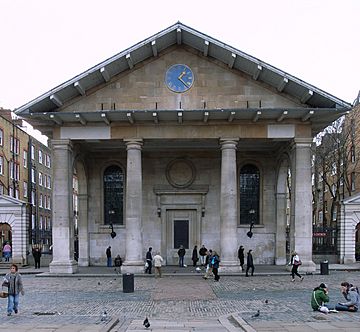
During the Caroline era, a new style of building came to Britain from Italy and France. This was Palladianism, and the most important person to bring it to England was Inigo Jones. Jones traveled in Italy and studied the work of the Italian architect Palladio. He designed several important buildings in this style, like the Queen's House at Greenwich and the Banqueting House at Whitehall.
Jones also designed St Paul's, Covent Garden (1631). This was the first completely new English church built since the Reformation. It showed a simple, strong Roman style.
Many large houses built during this time were in a style called "Artisan Mannerism." This style grew out of older English architecture. Often, the builders themselves helped design these houses. A famous stonemason named Nicholas Stone was a leading sculptor and also worked on buildings.
An example is Swakeleys House (1638) near London. It was built for a wealthy merchant. This house shows how different the King's court taste was from the taste of people in the city. Other houses from the 1630s, like Kew Palace (the "Dutch House"), also show this style. They were often built with brick and had decorative elements.
After King Charles I was executed, the Palladian style was seen as too connected to the King. So, it became less popular. Later, new styles like Baroque became more common.
Science and New Ideas
Medicine: Understanding the Body
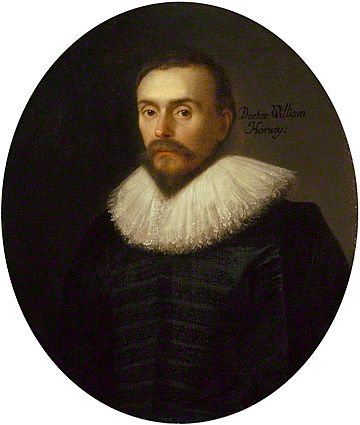
Medicine made a big leap forward in 1628. That year, William Harvey published his study on the circulatory system. His book, Exercitatio Anatomica de Motu Cordis et Sanguinis in Animalibus, explained how the heart pumps blood around the body. At first, many people didn't accept his ideas. But later, his work was recognized as very important.
New Ways of Thinking
The Caroline era was a time when new ways of thinking about science were developing. Francis Bacon (who died in 1626) had already started ideas that would later lead to the creation of the Royal Society (a famous scientific group) in 1660. Bacon's book, New Atlantis, published in 1627, shared new ideas that many people found interesting.
During this time, there were no official science organizations. So, scientists and thinkers often met in informal groups. They sometimes got support from rich nobles who were interested in science. These groups helped to reduce the popularity of older mystical ideas like alchemy and astrology.
Mathematics: New Symbols
In mathematics, two important books were published in 1631. They were Thomas Harriot's Artis analyticae praxis and William Oughtred's Clavis mathematicae. Both books helped to create the modern language of mathematics. Harriot's book, for example, introduced the  sign for multiplication.
sign for multiplication.
The famous philosopher Thomas Hobbes was also writing his important ideas during this period. However, his main works were published after the Caroline era ended.
Religion: Big Debates
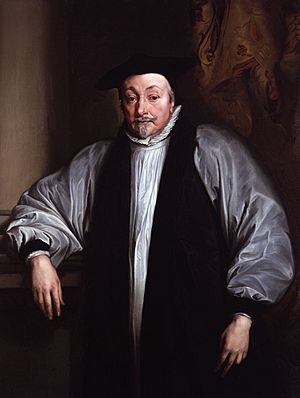
Most people in England, Scotland, and Ireland believed that a king's rule was given by God. But they disagreed on what a "well-ordered" monarchy meant. They also argued about who should have the final say in church matters.
- Episcopalians supported a church led by bishops, who were chosen by the King.
- Puritans believed the King should answer to church leaders chosen by their local communities.
The Caroline period was full of intense debates about religious practices. In Scotland, the church was mostly Presbyterian. But in England, things were more complicated. "Puritan" was a general term for anyone who wanted to "purify" the Church of England. This included many different groups, like Presbyterians and Congregationalists. Religion and politics were closely linked. Bishops, for example, sat in the House of Lords (part of Parliament) and could block laws.
Even though King Charles was a strong Protestant, many people, even those who supported bishops, did not like the fancy church rituals he tried to bring in. These rituals often seemed too much like Catholic practices, which made many people suspicious. This was partly because changes in religion were often seen as changes in politics. Also, during the Thirty Years' War in Europe, people worried that Charles was not doing enough to support Protestant countries against Catholic powers.
Charles worked closely with Archbishop William Laud to change the church. They prepared a new Book of Common Prayer. Some historians believe Charles was the main person pushing for these religious changes.
Scottish people resisted Charles's reforms. This led to the Bishops Wars in 1639 and 1640. These wars removed bishops from the Scottish church. Later, the English and Scots tried to create one unified Presbyterian church for both countries. But this idea was eventually dropped.
Foreign Relations: Peace and Colonies
King James I (Charles's father) truly wanted peace for his kingdoms and for all of Europe. Europe was divided and on the edge of the huge Thirty Years' War. Protestant countries faced threats from larger Catholic empires.
Charles inherited a weak navy. In the early years of his rule, many English ships were captured by Barbary pirates. These pirates, working for the Ottoman empire, took people as slaves. They even raided coastal towns in England. By 1626, it's thought that 4,500 Britons were held captive in North Africa.
The Duke of Buckingham was a very powerful figure in Britain. He wanted an alliance with Spain. In 1623, Buckingham took Charles to Spain to try and arrange a marriage with a Spanish princess. But Spain demanded that Britain stop being so anti-Catholic. Buckingham and Charles were embarrassed. Buckingham then pushed for war against Spain. Meanwhile, Protestant leaders in Europe looked to Britain for military help.
King James I managed to keep Britain out of the devastating Thirty Years' War. Charles I also tried to avoid war. From 1629 to 1640, Charles ruled England without Parliament. This time is called the Personal Rule. Since there was no money for war, peace was very important. Charles made peace with France and Spain. This meant England did not get deeply involved in the European war, which saved the country from much destruction.
Colonial Growth: New Settlements
Between 1620 and 1643, many people left England because they were unhappy with the religious situation. Most of these were Puritans who disliked the King's Catholic leanings. This movement is known as The Great Migration. About 80,000 people left England, and around 20,000 of them settled in North America, mostly in New England. These colonists were often families with some education who had been living well in England.
Carolina: A New Province
In 1629, King Charles gave a large area of land in what is now the United States to Sir Robert Heath. This area was named the Province of Carolana to honor the King. Heath tried to settle the area but failed. The first permanent settlers arrived later, during the reign of Charles II.
Maryland: A Place for All Faiths
In 1632, King Charles I granted land for Maryland to Lord Baltimore. Baltimore wanted to create a colony where Catholics and Protestants could live together peacefully. The new colony was named after Henrietta Maria of France, Charles I's Catholic wife.
Lord Baltimore invited both Catholic and Protestant settlers to Maryland. He offered them large amounts of land and promised religious tolerance. Most of the first 200 settlers were Protestant. A Jesuit priest, Father Andrew White, worked with Protestants to create the new settlement of St. Mary's City. This city is now seen as the birthplace of religious freedom in the United States.
In 1649, Maryland passed the Maryland Toleration Act, which made religious freedom a law. However, later in the century, Catholicism was outlawed in Maryland. Religious tolerance did not fully return until after the American Revolution.
Connecticut: Puritan Settlements
The Connecticut Colony started as several small settlements. The first English settlers arrived in 1633. In 1636, a main group of Puritans from Massachusetts Bay Colony, led by Thomas Hooker, established the Connecticut Colony at Hartford. Another settlement, New Haven Colony, was founded in 1638. These settlements were not officially approved by the King at first. They were recognized later, during the Carolean era.
Rhode Island: A Haven for Dissenters
Colony of Rhode Island and Providence Plantations (or just Rhode Island) was also founded during the Caroline era. People who disagreed with the Puritan leaders in Massachusetts Bay Colony moved to this area. The first group, led by Roger Williams, settled Providence Plantations in 1636. A year later, another group led by Anne Hutchinson settled on Aquidneck Island. These settlements gained some independence from Massachusetts Bay.
Barbados: Sugar and Slavery
The island of Barbados was claimed for England in 1625. In 1627, settlers arrived. In 1639, the colonists set up a local government. Farming grew with the introduction of sugar cane, tobacco, and cotton in the 1630s. This farming relied on indenture, where people worked for a set time to pay for their journey.
End of the Caroline Era
After Charles tried to arrest five members of Parliament in 1642, he declared war on Parliament. This started the English Civil War. The King fought against the armies of both the English and Scottish parliaments.
A key supporter of Charles was his nephew, Prince Rupert of the Rhine. Rupert was a brilliant general for the King during the Civil War. He was also active in the British navy and helped start important trading companies.
After Charles lost the Battle of Naseby in 1645, he gave himself up to the Scottish army. They later handed him over to the English Parliament. Charles was held at Hampton Court Palace. He refused to agree to Parliament's demands for a constitutional monarchy (where the King's power is limited by law). In 1647, he tried to escape but was quickly caught and imprisoned at Carisbrooke Castle.
From prison, Charles still tried to make deals. He formed an alliance with Scotland, promising to establish Presbyterianism there. A Scottish invasion of England was planned. However, by late 1648, Oliver Cromwell's army had taken control of England. The Scottish invaders were defeated at the Battle of Preston.
The King, now truly defeated, was put on trial. He was found guilty and executed in January 1649.
His execution happened outside the Banqueting House in Whitehall. This building had a famous ceiling painted by Rubens, which Charles had ordered. The King's art collection was later sold off. During his life, Charles had many enemies who criticized his spending on art. They said he wasted state money.
The Puritan victory in the Civil War greatly affected English culture. They closed theatres and made it harder for plays to be performed. Most importantly, they ended the King's support for artists and musicians. After Charles's execution, the arts did not fully recover until the monarchy was restored in 1660, starting the Carolean era under Charles II.
See also


